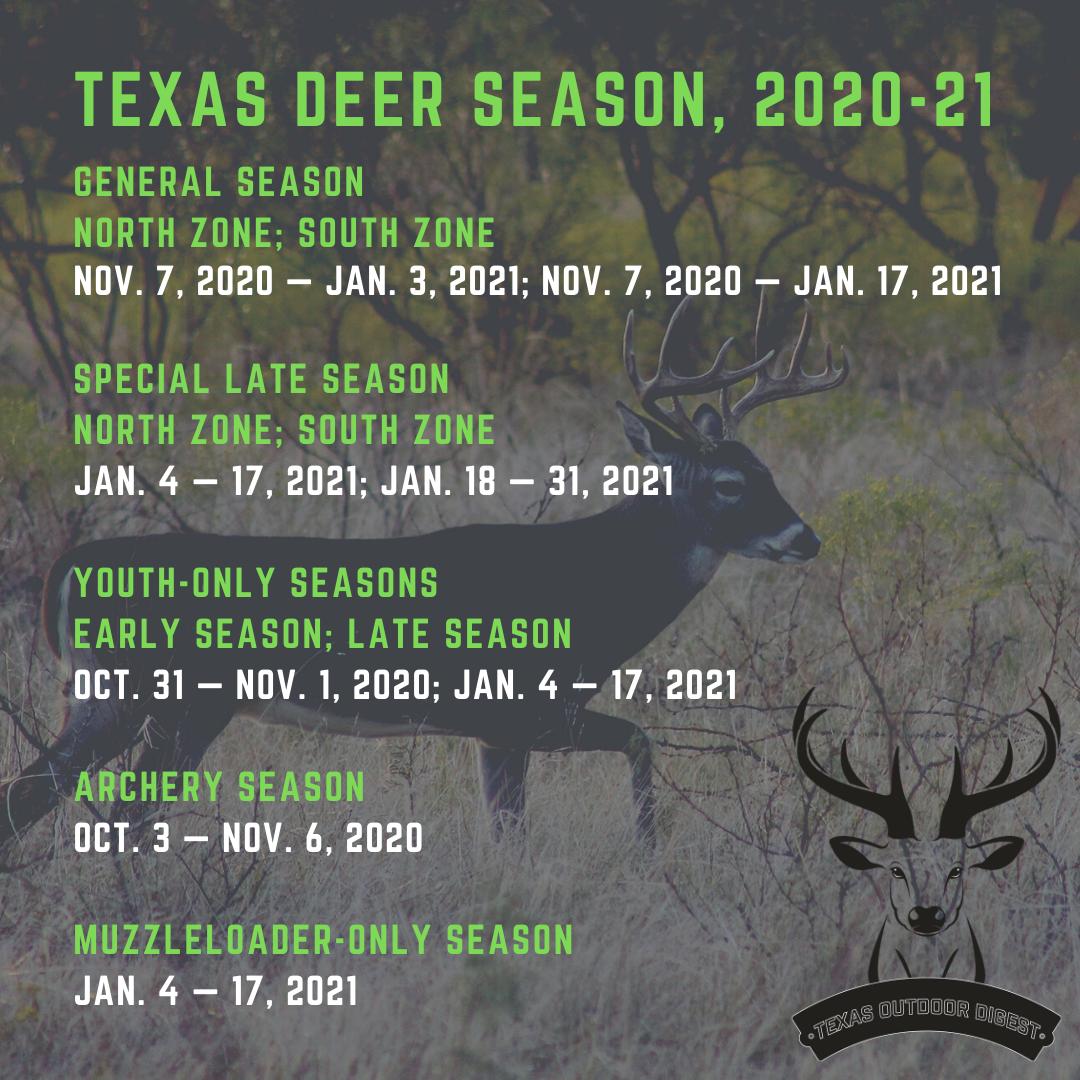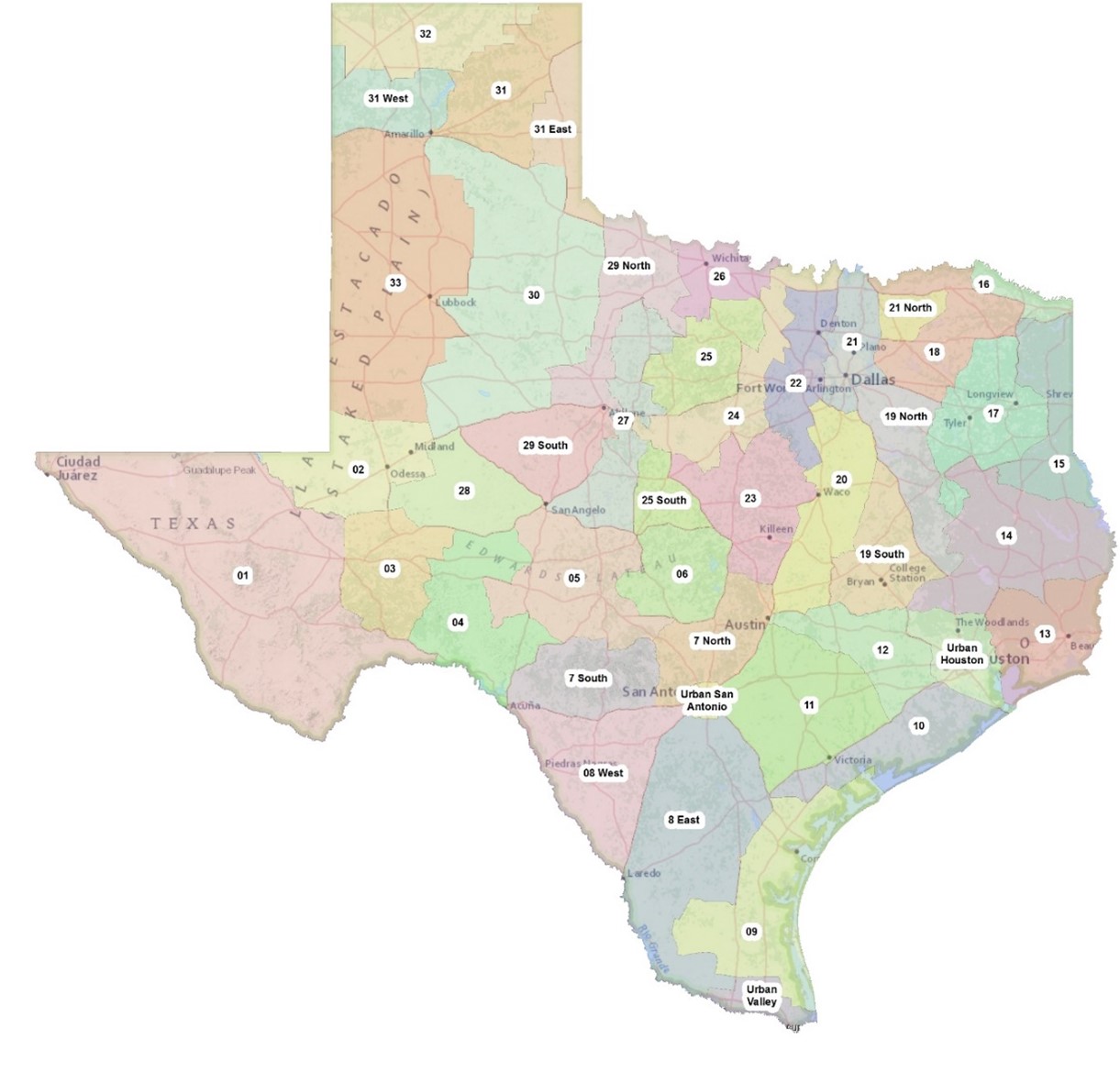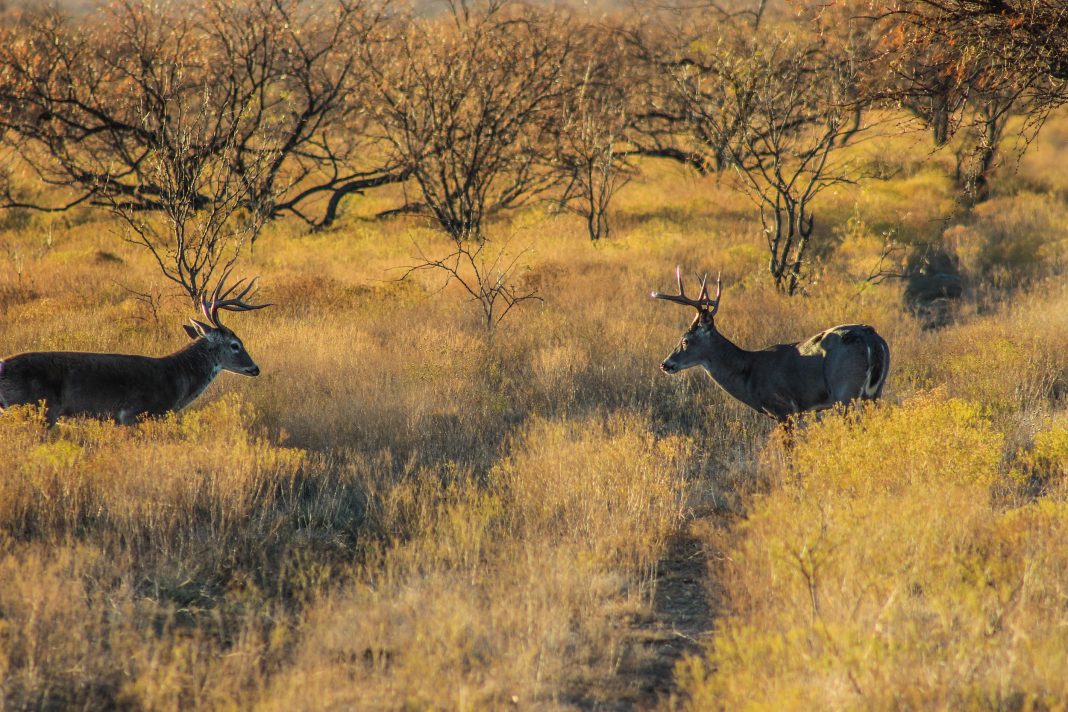
The ongoing COVID-19 pandemic has brought unpredictability into the lives of most hunters, especially those with travel plans that called on them to pass state or international boundaries to pursue wild game.
And while many hunters from the Lone Star State will continue to face uncertainty due to the ongoing health crisis, there is one silver lining that remains certain: the overall Texas deer hunting forecast is excellent.
The Texas Outdoor Digest asked Alan Cain, whitetail program leader for the Texas Parks & Wildlife Department, to provide his firsthand insight into how this fall and winter will shape up for quantity and quality in the Lone Star State.
Cain said that spring rains are always a good first indicator of just how good a deer season may end up being. He noted that 2020 got off to a great start in that regard.
“We’ve been blessed in Texas with well-distributed and timely precipitation across much of the state during late April, May and early June, and that has many hunters and deer managers hopeful for a great 2020 season,” Cain said. “These spring rains helped many areas of the state, including South Texas, the Edwards Plateau and areas west recover from very dry conditions persisting from fall and winter of 2019. The habitat conditions set the stage for good early antler growth and fawn recruitment numbers are looking good.”
Cain noted that Texas’ overall whitetail count — already the highest in the nation — has continued to expand, with new hunting opportunities being added in recent seasons.
“The deer population in the state continues to see positive long-term growth with most recent estimates around 5.5 million deer or a density of 49.35 deer per 1,000 acres,” Cain said, noting that the density is obviously not uniform across the state, with places like the Hill Country having much higher deer figures per acre.
“From a statewide perspective, hunters might expect to see a higher proportion of bucks in the 6.5- to 8.5-year age classes as a result of above-average fawn crop in previous corresponding years while other age classes reflect a more even distribution. Doe harvest has been down slightly the last couple of years, likely contributing to widening of the ratio of does to bucks from 2.95 in 2018 to 3.32 in 2019.
“The good news for hunters is that there should be plenty of carryover from previous years. Results from the TPWD annual big game harvest survey estimate 846,330 deer (54% bucks and 46% antlerless) harvested in the 2019 season, which was down about 4.2% from the 2018 season. Antlerless harvest was slightly up compared to 2018 while buck harvest was down 9.4% from 2018. The hunter success rate in 2019 was estimated to be 60% with an estimated 1.07 deer harvested per hunter or about 7.46 deer harvested per 1,000 acres. Similar harvest trends are expected for the 2020 season.”

Here’s the Texas white-tailed deer outlook for 2020-21, which overall has shaped up to be excellent in almost every hunting hot spot, broken down by region with facts and figures from Cain.
Hill Country Deer Outlook
“The Edwards Plateau, located in the central part of Texas, has the highest deer population in the state with an estimate of about 2.37 million deer,” Cain said. “Population numbers are expected to be down from 2019 as a result of an extensive anthrax outbreak in DMUs 4 and 5 on the western portion of the region. Anecdotal reports from ranchers in that affected area estimate localized mortality rates as high as 90% on some properties, but mortality loss was not uniform, and many ranches reported only minor death loss attributed to anthrax. In some instances, such losses provided long-term benefits by reducing deer densities and bringing them in line with natural carrying capacity of the native rangeland. This population reduction should result in healthier deer and hopefully more nutrition to help bucks maximize antler production.
“Despite the 2019 anthrax outbreak and population impacts, there are still abundant deer throughout the majority of the region and hunters looking for opportunities to see lots of deer when afield should put the Hill Country on the priority list to hunt this fall. Hunter success in this region runs about 76% with an estimated 12.7 deer harvested per 1,000 acres in 2019. Within the Plateau there are six deer management units with densities ranging from 293 per 1,000 acres to 42 deer per 1,000 acres. The area around Llano and Mason counties (DMU 6) has the highest density in the region with most recent estimates of 293.23 deer per 1,000 acres.
“Hunters are encouraged to harvest as many does as possible in most of the Plateau in order to lower deer populations to relive browsing pressure on habitats and bring the doe to buck ratio more in balance.
“Hunters can expect to see a larger percentage of bucks in the 4.5- to 7.5-year age range relative to other age classes as a result of high fawn production in prior corresponding years. Hunters looking for older age class bucks should focus on DMU 4, that area from Del Rio to Junction, and DMU 7 south, the area between Hondo to Del Rio and north of 90. The three-year average indicates that 46.7% of harvested bucks were 4.5 years old or older in DMU 4 and 45.9% in DMU 7 South. Overall, the Hill Country is a great deer hunting region and expectations are above-average for the 2020 season.”
South Texas Deer Outlook
“At the close of the 2019-20 hunting season South Texas was experiencing tough condition with most areas not receiving any reasonable rainfall since August 2019,” Cain said. “Range conditions were on the decline with very few winter weeds and little to no green growth on many key brush species. Those properties with a supplemental feed program saw less impact as deer still had some fat reserves heading into early February.
“Had habitat conditions not improved with the April and May rains, South Texas would have been in a for a tough 2020 hunting season at least in the context of antler quality. However, relatively mild temperatures and good rains this spring set the stage for another good season especially in the eastern half of the region and south toward the Rio Grande Valley.
“Deer populations in the region are stable with most recent population estimates of 438,000 deer. Three deer management units are represented in the South Texas Region and deer densities range from 15 deer per 1,000 acres to 40 deer per 1,000 acres. With good fawning conditions and reports of large number of fawns on the ground as of early July, the 2020 population estimate is expected to remain stable or show a slight increase. Sex ratio estimates are expected to be around 2.2 does per buck, similar to 2019 estimates. Hunters should expect to see more 5.5-year-old bucks in the population as a result of a fawn crop in 2015, but fewer bucks in that 6.5 or older age group.
“Mature bucks tend to dominate the harvest in South Texas with 53% being 4.5 years old or older, and when adding 3.5-year-old bucks in, that number jumps to 68%. Hunters looking to pursue mature bucks should consider South Texas. Antler quality is expected to be at least average and maybe better than average. The average Boone & Crockett score for a 5.5+ buck in 2019 was 130.87 B&C and up from the previous two years.”
Post Oak Savannah Deer Outlook
“The estimated deer densities in the Post Oak Savannah range from 26 to 89 deer per 1,000 acres with highest densities occurring in DMU 11, that area along the Interstate 10 corridor from San Antonio to Houston,” Cain said. “Deer populations in the southern part of the region have seen a slow but steady increase over the last 15 years. In efforts to help address the growing deer population in this area, TPWD opened a four-day antlerless season during Thanksgiving this past hunting season. Hunters were required to report antlerless deer harvest via the TPWD My Hunt Harvest app to help biologists assess harvest impact on that population (counties include Austin, Bastrop, Caldwell, Colorado, Dewitt, Fayette, Gonzales, Guadalupe, Karnes, Lavaca, Lee, Waller, Washington, and Wilson. Counties also included in that change are Goliad, Jackson, Victoria, and Wharton counties north of U.S. Highway 59 and Comal, Hays and Travis east of IH-35).
“The total reported antlerless harvest in the 21 counties where mandatory reporting is required was 3,978 antlerless deer. In those same 21 counties, an additional 17,313 antlerless deer were harvested through the MLDP program. The doe days only resulted in an additional harvest of 1 antlerless deer per 1,830 acres. The new doe day season did not appear to have a significant impact on the deer population in DMU 11 and population trends are expected to remain stable to slightly increasing in these southern deer management units.
“Moving northward, deer densities tend to decrease in DMU 19 North and 18 where habitat fragmentation impact deer distribution and overall population growth. Good habitat conditions this spring should contribute to an above-average fawn production year, sustaining current population numbers moving into the 2020 season.
“Age and antler surveys indicate that 68% of the buck harvest was represented by bucks 3.5 years old or older in 2019 and hunters should expect this trend to continue in 2020 with some good quality bucks being available for harvest. Relative to other age classes, there may be a few less bucks in the 4.5- to 5.5-year-old age classes as a result of low fawn crops in 2016 and 2017. Hunters should also notice a good number of 1.5- to 3.5-year-old bucks in the population as well. Considering forage conditions and availability, antler quality is expected to be good for the 2020 season and likely above the 2019 average of 123 B&C for bucks 5.5 or older. Hunter success in the region was estimated to be 63% in 2019 and follows similar trends for the last several years.”
Pineywoods Deer Outlook
“The most recent population estimate in East Texas is 286,000 deer, a positive increase over the previous two years. That positive trend in population growth is expected to continue in 2020 with favorable conditions for a high fawn recruitment,” Cain said. “Deer densities range from a low of 7.88 deer per 1,000 acres in DMU 13 in the southern portion of the Pineywoods to 25.25 deer per 1,000 acres in DMU 14 in the central portion of the region. Although deer densities are lower than other regions of the state, those properties engaged in good habitat management practices are seeing good deer densities and good fawn recruitment.
“Based on previous years of fawn production, hunters should expect to see a good number of 2.5-, 3.5- and 7.5-year-old bucks relative to other age classes. Buck harvest trends indicate that 53.4% of the buck harvest were bucks 3.5 years old or older, a byproduct of the antler restriction regulation. Hunters should expect the same trend for 2020, and as always, the region is likely to produce some tremendous bucks.
“Hunter success in 2019 was estimated to be 56% and a harvest of 6.13 deer per 1,000 acres with harvest trends expected to remain stable in the Pineywoods for the upcoming season.”
Cross Timbers Deer Outlook
“The Cross Timbers region in North Texas has the second-highest deer population in the state, just behind the Edwards Plateau region,” Cain said. “The Cross Timbers encompasses five DMUs with deer densities ranging from 14 to 88 deer per 1,000 acres. The highest deer densities occur in DMU 23 (88 deer per 1,000 acres) and DMU 25 South (81 deer per 1,000 acres) in the central portion of the region.
“Fawn production in the Cross Timbers has generally been greater than 50% for the last eight years and 2020 is expected to be at least average if not above-average as a result of great range conditions, especially in the eastern portion of the Cross Timbers. As a result of these relatively consistent fawn crops, age structure of the buck herd is well-distributed. Hunters may notice a few additional 7.5- and 8.5-year-old bucks relative to other age classes as 2012 and 2013 were good fawn recruitment years.
“Harvest trends for 2019 indicate that 70% of the buck harvest was represented by bucks 3.5 or older, above the long-term average of 57.3%. Hunters should expect to see good numbers of mature bucks in the harvest for 2020. Hunter success for 2019 was estimated to be 60% and a harvest of 7.43 deer per 1,000 acres.”
Rolling Plains Deer Outlook
“The eastern and western Rolling Plains region generally have lower deer populations compared to other ecoregions, with deer densities ranging from 31 to 69 deer per 1,000 acres in the eastern Rolling Plains, and 21 to 33 deer per 1,000 acres in the western Rolling Plains,” Cain said. “Population trends are stable but fawn production is expected to be down for 2020 in the Western Rolling Plains that missed most of the spring rains.
“The projected number of bucks in the 4.5- to 5.5- and 7.5-year-old age classes will be higher relative to other age groups in both regions of the Rolling Plains. In 2019, 85% of the buck harvest in the western Rolling Plains was represented by bucks 3.5 or older, well above the previous year and the long-term average of 70%. Because of larger property sizes and relatively light hunting pressure, as well as more interest in deer management, harvest trends of older age class bucks are expected to continue in 2020.
“In the eastern Rolling Plains, bucks 3.5 or older represented about 79% of the harvest in 2019 with the long-term average of 63%. Hunters should expect this trend to continue in 2020, and if looking for mature bucks, this would be a good region to consider. Harvest success is slightly higher in the eastern Rolling plains (74%) than in the western Rolling Plains, 69%. Harvest per 1,000 acres in 2019 was estimated to be 7.3 in the eastern plains and 2.8 deer per 1,000 acres in the western plains. The lower harvest rates in the western portion of the region are not unexpected with much lower deer densities.”
Texas Chronic Wasting Disease
“Hunters are reminded to review TPWD’s chronic wasting disease Web page for information about CWD testing requirements and carcass movement restrictions in the CWD zones for the 2020-21 season,” Cain said. “A new CWD zone has been in established in Kimble County, near Segovia. Mandatory sampling of hunter-harvested deer and carcass movement restrictions apply in this new zone.
“Also, as a reminder, Texas hunters harvesting deer, elk, moose or other susceptible species in other CWD-positive states must also comply with carcass movement restrictions when bringing those harvested animals back into Texas. Those requirements and additional information on CWD can be can be found on the TPWD CWD webpage. Additionally, the Texas Animal Health Commission has mandatory testing requirement that apply statewide to harvested exotic CWD susceptible species such as elk, red deer, sika, moose and reindeer.”
Tracking of wounded game the responsibility of ethical Texas hunters
Correctly sizing up deer, antelope adds to Texas hunting experiences
Texas deer hunting enjoyment not just about pulling the trigger




















